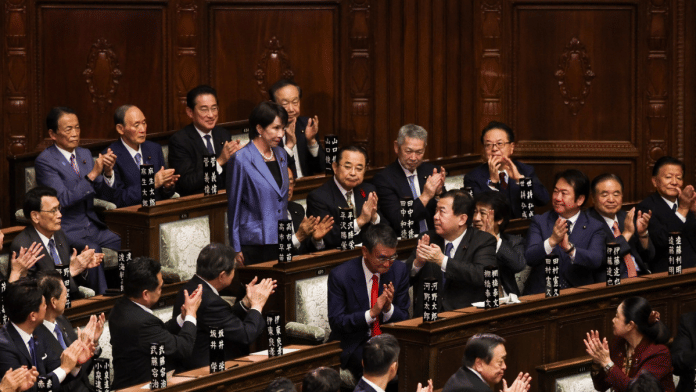New Delhi: The appointment of Japan’s first female Prime Minister Sanae Takaichi, known for her hawkish stance on China and unwavering support for Taiwan, sets the stage for a potential rift between Tokyo and Beijing even as India-Japan ties appear poised for further strengthening.
A protégé of late PM Shinzo Abe, the 104th Japanese premier has publicly spoken about reviving ‘Abenomics’ to address the nation’s challenges—among them sluggish economic growth, mounting debt, labour shortages and political instability in recent years.
“The challenges to the Takaichi premiership are largely internal to build consensus for foreign and security policy. While she is a staunch supporter of free and open Indo-Pacific, her sustained leadership will be crucial to steer Japan from consistent turbulence in its internal situation,” said Professor Harsh V. Pant, vice-president, studies and foreign policy at Observer Research Foundation.
Takaichi’s rise comes at a difficult juncture for the Liberal Democratic Party (LDP), which lost majority in the country’s Upper House this year and forced the party into a coalition with the conservative Japan Innovation Party, also known as Nippon Ishin no Kai.
Her predecessor Shigeru Ishiba resigned after taking responsibility for the electoral debacle. Takaichi secured the premiership with 237 votes in the inter-party election—just four more than the majority mark.
Also Read: Japan’s Takaichi makes history, but women ask: what changes now?
Uneasy ties
Takaichi, who calls herself the ‘Margaret Thatcher of Japan’, has been a vocal supporter of Taiwan, making frequent visits to the island, including an April trip where she urged stronger Tokyo-Taipei security ties, in a position that challenges Beijing’s ‘One-China’ principle. Her visible opposition to any forceful or coercive change to status quo is also seen as a direct rebuke to Chinese ambitions in the region.
The newly appointed Japanese PM has also advocated revising Article 9 of Japan’s pacifist constitution to enable strengthening of the Japan Self-Defence Forces (JSDF).
Her leadership, if it sustains, could significantly expand Japan’s presence in the Indo-Pacific region and counter Beijing’s long-term interests.
Takaichi’s visits to the Yasukuni Shrine, where the remains of convicted Japanese war criminals from World War II lie, have provoked Beijing and Seoul in the past too. But she skipped this year’s autumn festival at the shrine, signalling possible restraint as leader of the nation.
Beijing’s unease with Takaichi’s appointment was evident in a statement by Chinese foreign ministry spokesperson Guo Jiakun earlier this month.
“We hope that Japan will work with China in the same direction, uphold the principles of the four political documents between the two countries, honour its political commitment on major questions such as history and Taiwan, maintain the political foundation of bilateral relations, and advance the China-Japan strategic relationship of mutual benefit in an all-round way,” Jiakun had said.
India sees continuity
In New Delhi, Takaichi’s premiership is largely viewed as a continuation of Abe’s legacy, with expectations that she will strengthen Japan’s partnership with India. Her unwavering stand on China is an added benefit that reinforces New Delhi’s vision of a free and open Indo-Pacific.
“Bilateral ties are already on a solid footing, and Sanae Takaichi’s leadership is likely to reinforce India–Japan relations, building on the strategic framework laid by Shinzo Abe. Her alignment with Abe’s Indo-Pacific vision suggests greater policy continuity than departure,” said Pratnashree Basu, fellow at The Japan Foundation (JFIPP), an independent administrative institution under the country’s ministry of foreign affairs and associate fellow at ORF.
But there are apprehensions about Takaichi’s stricter stand against foreign immigrants. Her newly formed cabinet introduced the post of a minister ‘in charge of a society of well-ordered and harmonious existence with foreign nationals’.
The topic was a key electoral issue in latest polls and LDP’s coalition partner, JIP, has earlier proposed putting a cap on the percentage of foreign residents in Japan.
The Takaichi government’s stand on immigration will be closely watched by New Delhi, especially since the two countries in August signed a human resource partnership to facilitate the exchange of 5 lakh individuals, including 50,000 skilled professionals from India to Japan.
At the same summit, Prime Minister Narendra Modi and then Japanese PM Shigeru Ishiba declared the India-Japan Joint Vision to focus on strengthening security, economy, innovation, energy and people-to-people ties. Plans under it ranged from the Japan-India AI Cooperation Initiative, space collaborations like Chandrayaan-5 and progression of the Mumbai-Ahmedabad high-speed rail project with E10 Shinkansen trains.
“The most constructive scope for India-Japan collaboration lies in economic security, where both countries seek resilient supply chains in semiconductors, rare earths and digital infrastructure. Defence and maritime cooperation is also likely to deepen through expanded joint exercises, technology co-development and intelligence sharing across the Indo-Pacific,” added Basu.
But any ambition can be realised only if her and her party’s tenuous hold on power becomes certain.
Vaibhav Pant is a TPSJ alum, currently interning with ThePrint.
(Edited by Prerna Madan)
Also Read: Takaichi faces early test of defence ambitions with Trump visit






